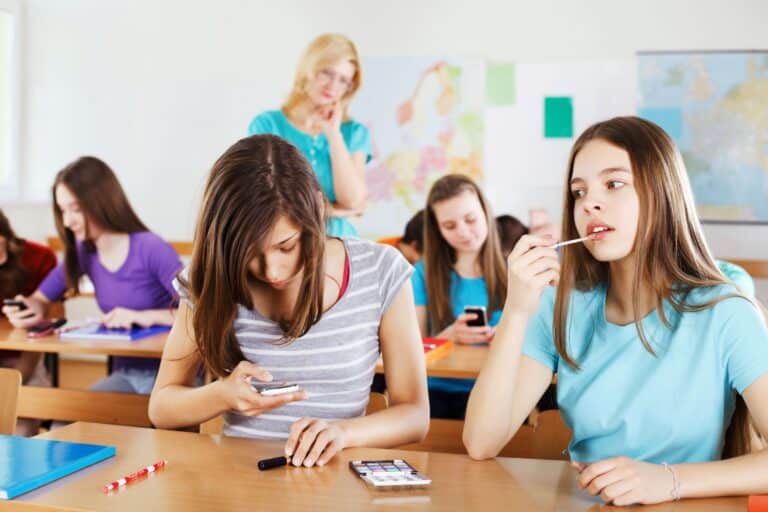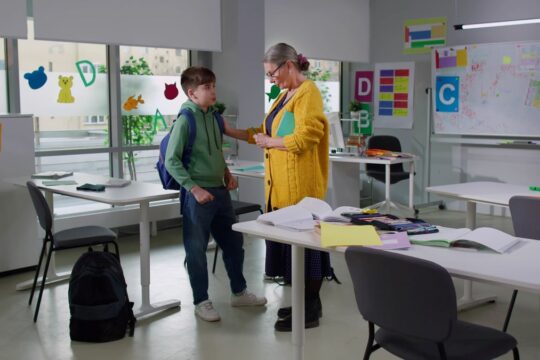Keeping a class focused is one of the most challenging aspects of teaching. It feels like you’re constantly in pursuit of your students’ attention, trying every trick in the book. And let’s be honest, most of us are just plain tired of repeating “Please stop talking” and “Eyes on me” on an endless loop. It’s frustrating.
You’ve already raised your voice more times than you wanted to. You’ve tried the countdown. You’ve tried the clap patterns. And yet… the noise keeps rising, and your patience keeps wearing thin.
But here’s the thing – there are ways to redirect your students’ attention without losing your voice or your mind. These strategies are simple, low-prep, and best of all, they actually work. You don’t need to become a drill sergeant to bring the energy back down and regain control of your classroom.
Sometimes it just takes a little creativity and a willingness to switch things up. Here are five practical, teacher-tested ways to get your class back on track when their focus flies out the window.
1. Try a “Tech Break”
We’ve all heard of brain breaks, but let’s talk about a different kind of reset, a “tech break.” We’re not talking about putting on a movie or letting your students play video games all day. But giving your students a few structured minutes to explore something on a device (a drawing app, a puzzle game, a quick educational video, or even a timer-based typing game) can actually help them get it out of their system.
Today’s students are constantly surrounded by technology, it’s how they connect, explore, and even relax. Giving them a short, intentional tech break feels like a reward, but it’s really just a smart way to shift their focus. For example, you might allocate five minutes at the beginning of a lesson for students to check an educational app or participate in a digital quiz.
After the break, you’ll often find that they’re more willing to engage in whatever comes next because their minds feel refreshed. Over time, these scheduled tech breaks can help create a more balanced classroom where technology is part of the learning process rather than a constant source of distraction.
2. Leverage the Power of Sound with Instruments
Sometimes your students just tune out your voice. It’s not personal, they’ve been hearing you talk for hours. So, if your usual attention-getters aren’t cutting through the classroom noise, it might be time to try something different like using musical instruments. Grab a chime, a small bell, a triangle, or even a rain stick.
These simple instruments have a magic quality to them. They break through the classroom noise in a way your voice can’t. This unexpected sound can work wonders in snapping everyone back to attention. It also doesn’t feel like a demand; it just feels like a cue. And most of the time, it works immediately. When you introduce this method, explain to your class that the sound is their cue to stop what they’re doing and direct their attention toward you.
With regular use, this technique can become an automatic response that cuts through chatter and distractions, making transitions between activities smoother and more efficient.
3. Make Brain Breaks Part of Your Daily Routine
If you’re not using brain breaks yet, you’re missing a golden opportunity. These short bursts of movement and fun can completely reset your students’ energy levels. These breaks are not just pauses; they are carefully designed opportunities for students to reset and reenergize. You don’t need fancy equipment or a ton of prep.
A quick dance party, a few stretches, a freeze game, or a minute of jumping jacks will do the trick. The key is consistency—if students know they’ll get a break, they’re more likely to give you their full attention before and after.
When planning brain breaks, consider the age and energy level of your students. Younger children might benefit from simple dance moves or a round of “Simon Says,” while older students might enjoy a quick mindfulness exercise or a guided breathing session. By tailoring these breaks to your class’s unique needs, you provide a vital tool for managing energy levels and sustaining attention during lessons.
4. Get Physical with Interactive Attention Grabbers
For many elementary educators, the tried-and-true call-and-response technique is a go-to for regaining attention. But if your students are starting to ignore those old go-to phrases, it’s time to level it up and add a physical element. Take, for example, a playful chant such as “Zip it, lock it, put it in your pocket.”
As you lead the chant, students perform the actions: zipping their lips, miming the act of locking something, and then tucking their hands into their pockets. This multi-sensory approach ensures that students are not only listening but also moving.
The physical activity associated with the chant helps to interrupt any ongoing distractions and refocuses their energy on the collective task at hand. Not to mention, interactive physical activities foster a sense of community within the classroom. When everyone participates, there’s an added layer of engagement and excitement.
5. Employ Visual Cues for Immediate Focus
Sometimes words just aren’t enough, and you have to let visuals do the talking. A quick flash of a visual cue can instantly grab attention without saying a word. Whether it’s a hand signal, a color-coded light, or a classroom sign, visual tools work wonders in classrooms of all ages.
One tool that many teachers swear by is a Time Tracker stoplight. It has green, yellow, and red lights that signal how much time is left in an activity. The visual countdown helps students manage their own attention. You can program it to switch from green to yellow to red based on the timing of your lesson, and many versions come with sound options for an added cue. Not ready to invest in a gadget? No problem. You could create a custom chart that outlines the day’s schedule or specific class rules.
This visual aid can be placed in a prominent spot in the classroom where it’s easily visible to everyone. The goal is to establish a clear, consistent signal that lets students know when it’s time to focus, regroup, or switch activities.
Refocusing your class isn’t a one-time event, it’s an ongoing process that happens multiple times throughout the day. Each method outlined here has been tried and tested in various classroom settings, and what works best can vary depending on your student’s age, interests, and the overall classroom dynamic. The important takeaway is that you have a toolbox of strategies at your disposal.
Educators never stop learning; check out our available graduate degree programs to hone your skills and promote lifelong learning and academic excellence.




